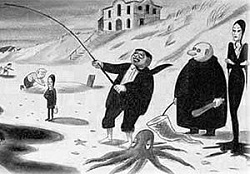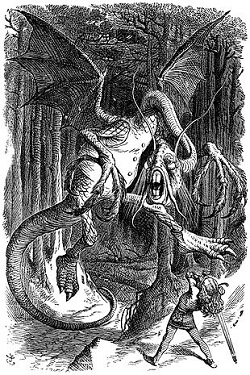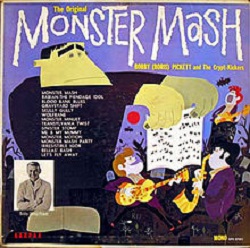Back in October 2015 my choir gave a concert titled “BOO!” We had so much fun with doing a Halloween-themed program. Here are three short essays about songs we sang that include some kind of monster theme.
 Is the Addams family really ooky?
Is the Addams family really ooky?
Part of the lyrics read:
They’re creepy and they’re kooky,
mysterious and spooky.
They’re altogether ooky–
the Addams Family.
“Ooky” is a made-up word by the songwriter Vic Mizzy, who composed this theme song as well as the one for Green Acres. It supposedly means “creepy, scary, weird,” and I guess in some ways the Addamses could be described that way. Some of the funniest scenes from the series come about when so-called “normal” people visit their house, with its trapdoors, roaring lion, cadaverous butler, suits of armor, and proximity to a cemetery. (“Their house is a museum.”) The family gets its surname from Charles Addams, who first introduced these characters in cartoons he drew for the New Yorker magazine.
But . . . just as with The Nightmare Before Christmas that I posted about previously, strange characters do not necessarily make for an evil atmosphere. In fact, as my husband is fond of saying, this household of so-called freaks was really one of the nicest families on television at the time. No one made fun of anyone else; everyone was appreciative of the others’ interests. (So Gomez admired Morticia’s paintings of dead flowers.) There was absolutely no embarrassment about their differences, no felt need to fit in with the rest of society. If there was trouble at school with Wednesday and Pugsley, the two children, the parents were right there in the principal’s office dealing with it. There’s a lot of talk about having a “family identity” these days; well, the Addams family had buckets of that. Not such a bad thing.
 What on earth is a Jabberwock?
What on earth is a Jabberwock?
Smart-aleck answer: It isn’t on earth at all; it’s imaginary.
Okay. Sorry. I hope that as a cultured person (otherwise you wouldn’t be reading this post), you are familiar with the great classics Alice in Wonderland and Through the Looking Glass by Lewis Carroll. These are actually two separate books but are often printed together in one volume. In Wonderland, Alice goes down the rabbit hole after the White Rabbit; in Looking Glass she steps through the mirror in her parlor and ends up in a topsy-turvy world where chess pieces and nursery-rhyme figures come to life, among other strange events. Alice finds a book containing the poem “Jabberwocky” but can’t understand many of the words; as she says, “Somebody killed something: that’s clear, at any rate.” Later on Alice meets up with Humpty-Dumpty and asks for his help in understanding it; they get through only the first verse. The explanation of even that short section is too long for this post; I will just give H-D’s definition of “brillig”: “‘Brillig’ means four o’clock in the afternoon — the time when you begin broiling things for dinner.” If you’d like to read his explication of the entire first verse, go to “Through the Looking Glass,” chapter 6 and scroll down about halfway through. It’s interesting to note that Lewis Carroll made up many words in the poem, even some that aren’t just combinations (such as “mimsy,” meaning “flimsy” and “miserable”). “Chortle” and “galumph” are two that have passed into at least semi-common use. In his addition of words to the English language Carroll thus shares an accomplishment with William Shakespeare. But don’t worry about understanding all the words in “Jabberwocky” and just enjoy the fun—and the sound effects.
And, finally:
 Can we trace the original inspiration of that great masterpiece, “Monster Mash”?
Can we trace the original inspiration of that great masterpiece, “Monster Mash”?
Why yes. I’m glad you asked. Bobby Pickett, an aspiring actor who played with a band on the side, wrote this novelty hit in 1962. He had made up a monologue from horror movies using an imitation of Boris Karloff’s voice while performing The Diamonds’ “Little Darlin’.” The audience liked it and a fellow band member encouraged Pickett to do more with the song, so he developed a full-fledged performance, adding in an imitation of Bela Lugosi for the voice of Dracula. The story of the song revolved around the usual mad scientist creating a monster, but in this case it rose from its slab to do a dance. And why a “mash”? Well, a craze at the time was for a dance called the “Mashed Potato,” popularized by James Brown and resembling the Twist, but with some foot-twisting thrown in that was supposed to symbolize how you’d go about mashing potatoes. (I use an electric mixer myself.) I’m sure that if I delved deeply enough into the James Brown oeuvre I could find out why he was so interested in this food item; maybe his mom made an especially tasty version. Anyway, the dance that the monster does has footwork like the original dance but with Frankenstein-like arm movements. As the song goes on various other weirdities show up, and by the end there’s a full roster of monsters, so to speak, all dancing away.
Here’s a video of the Addams Family theme being performed by a high-school choir. Video quality isn’t great, but the teens really give it their all and do a great job:
And a great performance of “Jabberwocky,” complete with sound effects:
And, finally, a performance of “Monster Mash” that’s just a complete hoot:
© Debi Simons

